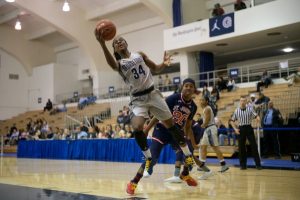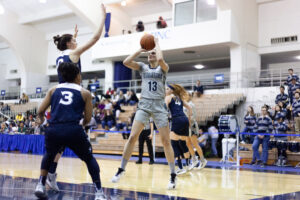Every March, fans across the country wait with bated breath for the reveal of the NCAA Basketball Tournament Bracket. North Carolina dropped to a 2-seed. Gasp. Arkansas is revealed at No. 4. Shock. Georgetown made the tournament this year! WHOA. “Selection Sunday” is a pseudo-holiday at this point, marking the beginning of March Madness, the affectionate nickname for the men’s basketball tournament.
Stories of shock and success have ingrained the historic tournament into our collective consciousness. The fabled ascendance of Georgetown basketball during the 1980s. Jimmy Valvano’s legendary survive-and-advance philosophy. A 16-seed upsetting a 1-seed for the first time in history, as University of Maryland, Baltimore County did to Virginia in 2018.
Historically, however, little attention has been paid to the women’s tournament, much less memorialization in bracket form. For example, the average viewership for the women’s championship game is only a third of what the men pull in. In addition, women’s college basketball makes only a fourth of the revenue the men’s season does—a direct reflection of the disproportionate attention and care historically placed on the twin league.
That being said, sports media has recently been on a fast break toward increasing visibility for women’s basketball. The NCAA extended the March Madness branding to the women’s tournament for the first time in 2022. While ESPN has shown all of the women’s tournament games for the past 20 years, the network decided in 2022 to move the women’s selection show from Monday to a Sunday timeslot alongside the men’s show.
As a result, viewership for the women’s 2023 selection show increased by 18.7 percent. With that increase in spectators comes the potential growth of the greatest tradition in college sports: bracket challenges.
But to discuss women’s basketball’s foray into the world of brackets, we need to talk about how March Madness bracket pools became so prolific that it seems like every club at Georgetown has one.
From their humble beginnings in a Staten Island bar, bracket pools exploded in the ’80s when the tournament expanded to 64 teams. Sports networks capitalized on their popularity with programming focused on analyzing the do-or-die March basketball scene. Offices, families, colleges, and friends began adopting bracket challenges. That same Staten Island bar had a prize pool of $1.5 million before the federal government shut it down. Even President Joe Biden has joined in the fun (despite his 2023 bracket busting in the first round).
One of the most enticing draws of the tournament is the nearly impossible odds of picking a perfect bracket. One in 9.2 quintillion. You are more likely to win the lottery, become president of the United States, or go on a date with that cute person in your discussion class. If anyone ever becomes the first to have the perfect run, they will instantly become a celebrity.
Who doesn’t want that chance at fame?
With glory on the line, spectators immerse themselves in these games. NewsNation reports that businesses lose $14 billion annually to workers watching “the Big Dance.” At my high school, classes shut down for the two hours the Arkansas Razorbacks played in the tournament. Call me a heretic, but March Madness may be the biggest holiday of the year.
But despite the recent rise in popularity and visibility, there are still disparities between the number of brackets filled out for each tournament. According to Forbes, there were 11 times fewer brackets made for women’s basketball in 2022 compared to men’s in ESPN’s Tournament Challenge.
A new era is starting, though. Last year, 76 percent more people watched the women’s tournament as compared to the previous season. That attention means more brackets and more prizes.
And the attention isn’t likely to slow. More sports networks are now committing to promoting the women’s tournament. In 2023, ESPN had a prize pool of $75,000 for both the men’s and women’s tournaments. Advertisement slots for women’s games and pregame shows both sold out quickly, with rights to the women’s tournament now estimated to be worth $112 million.
Just as sports networks latched onto men’s college basketball rivalries and storylines during the 1980s to launch multimillion dollar careers, women’s basketball is gaining significant coverage and narrative-building as their prominence in March Madness grows.
The UConn vs. South Carolina rivalry has received significant attention in recent years, especially when they met in the National Championship at the end of March. Dawn Staley and Geno Auriemma are generational coaches. Both are top 10 in recruiting rankings. Their meeting felt fabled, with article after article hyping each program up as titans of the game.
Some of this buzz is attributable to the teams’ recent March Madness branding and brackets. In a postgame video, the Gamecocks placed great emphasis on moving their name to the end of the bracket. The symbolism is potent for any viewer with a bracket. The team showed that they had arrived, and were ready to match their rivals.
Media and big performances during March Madness are also launching female student athletes into stardom with fans able to root for them through their brackets.
Iowa guard Caitlin Clark stamped her name into the March Madness history books, notching the first 40-point triple-double in both men’s and women’s tournament history. Celebrities across social media, like LeBron James, celebrated her accomplishment. James, who has 52.7 million followers on Twitter (now X), elevated her by saying, “Haha. But FR She’s so COLD!!!!!!! SHEESH.”
The growth of women’s college basketball looks more unstoppable than Aliyah Boston or A’ja Wilson. Sports media is fully buying into the sport, and they are finally bringing the fan attention each program deserves. Websites like ESPN’s Tournament Challenge and Yahoo Fantasy’s Women’s Tourney Pick’em have always made men’s bracket championships a spectacle, and now they’re finally starting to show the same appreciation to the women’s teams.
And maybe, just maybe, one of those women’s brackets will be the one in 9.2 quintillion.





